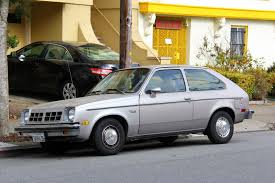The Leata Cabalero: The Pride of Idaho
/www.Driving.ca
Chalk up the Leata Cabalero as one of those ideas that seemed pretty good at the time. But this was a car of the 1970s, a time when few cars, or ideas, were much good.
The Leata Cabaero. That is the right spelling by the way, even though it isn’t. But then, little about the Cabalero is right, beginning with its origins. Anyone who has ever owned, driven, seen, or even heard of the Chevrolet Chevette, knows that this story isn’t going to end well. The Chevette was an aspiring of General Motor’s first attempt at building a World Car. It was built on 6 continents, sold in 80 countries under half a dozen banners…and charmed no one. Soon after the decade’s first energy crisis, GM began selling Chevettes in the U.S., where it was received by car enthusiasts like dog dropping on your neighborhood sidewalk. The Chevette was slow, cramped, noisy and ill-handling. But at least it was cheap… the cheapest, crappiest car in America.
www.CaliforniaStreets_Blogspot.com
The only good thing about the Chevette was its name…or rather its nickname. A girl who I dated for a while in college had one. Her name was Lilly, and she loved her “Vette.” I loved the way she said, “mah Vette,” in her Tennessee lilt. But truth be told, unless one of them had Lilly’s cute little tush in the driver’s seat, the Chevette was truly a turd.
So how was it that anyone could have concluded that by giving this a penalty box of an economy car a faux brougham interior, complete with cruise control and power windows, ladle on 350lbs of cheap plastic trim and bondo body enhancements, while offering no improvements on the 52hp gerbil-wheel of a motor and the barely adequate brakes, and then charge more than double the original car’s asking price, that the Leata Cabalero would be greeted in the market place with enthusiasm? Spoiler alert: It wasn’t.
www.Jalopnik.com
There is no good angle from which to view the Leata Cabalero. On first glance, it appears to have been designed by a circus midget who’d always wanted a Chevy Monto Carlo. A writer with a gift for linguistic imagery that far exceeds my own, Branden McAlleer in theDrive.com, describes the Cabalero as a “feculent lump of eyesore” with “bodywork swollen like a diabetic’s ankle…the Heartland’s arterial plaque.” A closer look suggests McAlleer may have been cutting the car some slack.
The Leata Cabalero was the brainchild of Donald E. Stinebauch of Port Falls, Idaho. Doug Clark, writing in the Spokesman Review, describes Mr. Stirebauch as a “machinist, inventor and a man with big dreams.” I suspect that he was also a talented tinkerer who let himself be carried away by a project…and maybe had a few too many beers with his buddies.
It also seems that Mr. Stinebauch was a romantic. He named his car after his wife. Mr. Clark’s piece doesn’t say if the Stinebauchs are still married. Hopefully Leata the wife had a sense of humor about Leata the car, and they are. It goes on to quote Stinebauch as saying, “I should have never got into it…I lost a lot of money.” A good follow up question might have been, why he did he make the Cabalero in the first place.
www.CurbsideClassic.com
Why indeed. As a car enthusiast, remembering the late 1970s can be a painful experience. But in doing so one can almost understand Don Stinebauch’s thinking. Just a few years earlier, the epicenter of the personal luxury car market had shifted from full sized cars like the Ford Thunderbird and Buick Riviera, to midsized platforms like the Chevy Monte Carlo and Chrysler Cordoba. And now, even compacts like the Nova-based Cadillac Seville were going brougham. Could this entrepreneur from Post Falls be faulted for anticipating that the super-mini category was sure to be next?
www.BangShift.com
It wasn’t.
Stinebauch built a total of 97 Leatas during 1976-77, and it is amazing that sales were even that high. Marketing materials bill the Leata as “The Pride of Idaho,” and it appears that most of them were sold to near-sighted residents of the Gem State. Almost all Leatas were hatchback sedans, although 3 were produced as a little pickup (El Camino-ettes?) Reportedly one convertible was also made, of which I’m rather glad I could find no picture. Some things can’t be unseen.
But doesn’t time heal all wounds? Not this one. Almost 40 years after the Leata’s unheralded demise, one of the few surviving Cabaleros took home the un-coveted “Worst-in-Show” award at the inaugural Motor City Concours d’ Lemons in 2014. The results were not contested.
Copyright@2021 by Mal Pearson





